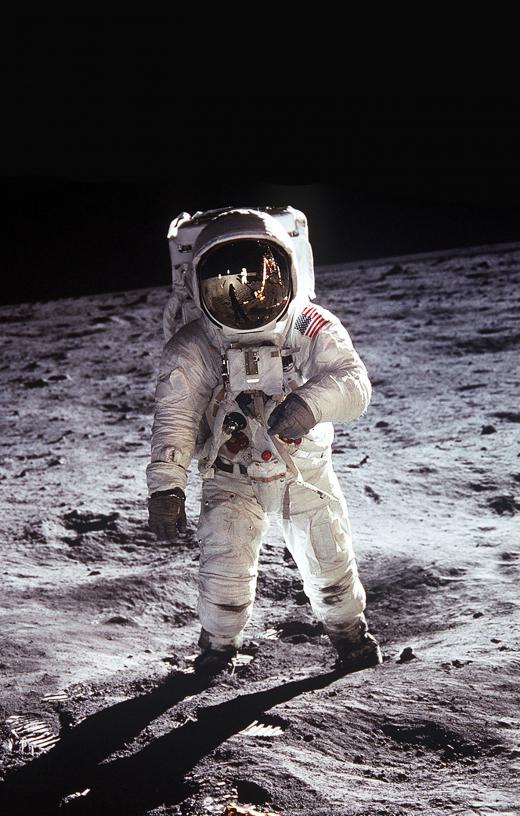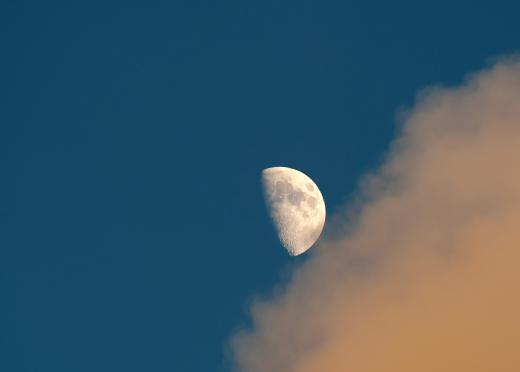What is the Content of Lunar Soil?
 Michael Anissimov
Michael Anissimov
As one might expect, the lunar soil (or regolith) is completely dry and airless. Before astronauts and probes visited the Moon, some scientists thought that parts of the surface might be covered in a fine layer of dust up to a mile deep, but this has seen been found to be false. The lunar soil is only about a couple of inches deep. It is covered in an extremely fine layer of dust that is electrically charged. This dust gets into everything and can be highly irritating to human skin.
The composition of lunar soil is primarily oxygen, just like the Earth's crust. Also like the Earth's crust, the most common substance is silicon dioxide, also known as silica, the primary component of sand, glass, and concrete. Broken down by element, about 43% of lunar soil is oxygen, 21% silicon, 13% iron, 8% calcium, 6% aluminum, 5% magnesium, and 4% other elements. Other compounds found in lunar soil include titanium dioxide, aluminum oxide (alumina, a gray substance that gives the Moon much of its color), iron oxide (rust), magnesium oxide, and calcium oxide (lime).

The composition of lunar soil varies significantly depending on whether one is considering the lunar highlands (which appear lighter) or the maria (lunar "seas"), which are dark. The lunar highlands are primarily anorthositic rock, which is characterized by a blend of 90% plagioclase feldspar (a class of silicate minerals) with a 10% metallic component like iron or magnesium. The feldspar component is made up of calcium, aluminum, silicon, and oxygen. These rocks are reflective and create moonlight when they reflect the Sun's light back to the nighttime Earth.

The lunar maria, the darker portion of the Moon, is made of basaltic minerals from ancient volcanic eruptions that occurred between 3.5 and 3 billion years ago. These minerals flowed into nearside basins (the far side of the Moon has barely any maria) and cooled. Compared to terrestrial basalts, they have a higher viscosity and greater iron content. In general, basalts are relatively rich in magnesium and calcium oxides and have lower levels of silicon dioxide.

In total, about 900 lb (400 kg) of Moon rock has been brought back from the Moon for scientists to analyze, about a pound of it from the Soviet Luna missions, about 100 pounds from asteroids kicked up from the surface of the Moon which fell in Antarctica or terrestrial deserts where they could be recovered, and the rest of it from the Apollo missions in the 60s and 70s.
AS FEATURED ON:
AS FEATURED ON:















Discussion Comments
It's amazing how much material we have brought back or found from the moon over the years, considering there weren't all that many moon missions and each one would have been very careful about spare space and weight. I guess they make plans to include soil samples before they leave though.
I wonder how much of it is actually in private hands. I remember seeing a lot of ads for "moon rocks" over the years. Are any of them genuine, or does NASA pretty much keep the stuff for their own analysis?
I know lunar meteorites might be more likely to be bought and sold, and in fact I've even heard that that is a bad thing, because of the loss to science. Some countries have rules that meteorites belong to the government, but there is always someone willing to break the law to make a profit.
I never thought about the moon quite like this before, but I guess if our moon didn't contain those reflective elements mentioned in the article, it wouldn't provide as much light to us each night.
I guess I always thought those pictures on science fiction covers with different colored moons were more fantasy than science, but I wonder if anyone has ever really thought about what, for example, the moons of Jupiter would look like if they replaced our moon.
Would we get any light off them at all? Would they be different colors? I know the shapes and the sizes are different, so it would affect all kinds of things, but I never thought that the different components of the soil would make so much difference.
Post your comments